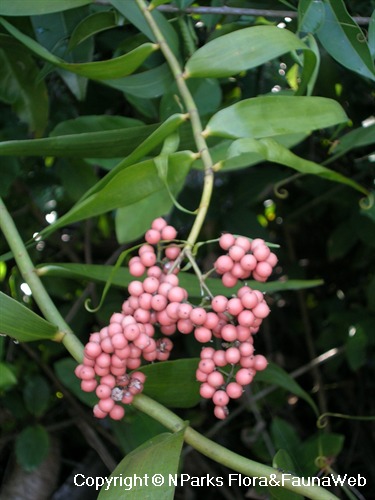
Back
Flagellaria indica L.
| Family Name: | Flagellariaceae |
| Synonyms: | Flagellaria indica (Blume) Hook.f. var. minor |
| Common Name: | Common Flagellaria, Rotan Dini, False Rattan, 须叶藤 |
Name
Classifications and Characteristics
| Plant Division | Angiosperms (Flowering Seed Plants) (Monocotyledon) |
|---|---|
| Plant Growth Form | Climber |
| Lifespan (in Singapore) | Perennial |
| Mode of Nutrition | Autotrophic |
| Maximum Height | 15 m |
Biogeography
| Native Distribution | From Tropical Africa to Sri Lanka, through tropical Southeast Asia, Melanesia, to north Australia, and the Pacific Islands |
|---|---|
| Native Habitat | Terrestrial (Primary Rainforest, Secondary Rainforest, Coastal Forest, Freshwater Swamp Forest) |
| Preferred Climate Zone | Tropical |
| Local Conservation Status | Native to Singapore (Least Concern (LC)) |
Description and Ethnobotany
| Growth Form | It is a perennial climber up to 15 m long. |
|---|---|
| Foliage | Its stalkless leaves are arranged in two rows on either side of the main stem. Its leaf blades are usually lance-shaped to linear, with tips tapering into slender tendrils, and 3–50 by 1.5–6.5 cm. The leaves include basal tubular sheaths overlapping and covering the stem. |
| Flowers | Its erect, much-branched flowering shoot is 3–30 cm long. The flowers are stalkless, small, white, and are found in very dense spikes at the ends of the branchlets. |
| Fruit | Its smooth fruits are usually 1-seeded, pink, round, and about 6.4 mm wide. |
| Habitat | It grows in open places by the sea. It is also found inland in edges of thickets and secondary growths, from sea level to 1500 m altitude. It occurs locally in Senoko area, Khatib Bongsu, Pulau Ubin, and Pulau Tekong, among others. |
| Associated Fauna | It is the preferred local food plant for caterpillars of the large dart butterfly (Potanthus serina), the adult of which lays its eggs singly either on the basal part or on the coiled tendril of the leaf blade. |
| Cultivation | It can be propagated by seed. |
| Etymology | Latin flagellum, tendrilled, referring to the leaf tips ending in coiled tendrils; Latin indica, of India but also applies to plants originating throughout the East Indies, referring to one locality in natural distribution of this species |
| Ethnobotanical Uses | Others: The tough stems are used as a substitute for rattan in making basket. The young shoots and leaves are used in making hair-wash. The plant is also used in various medicinal applications. |
Landscaping Features
| Desirable Plant Features | Ornamental Fruits |
|---|---|
| Landscape Uses | Parks & Gardens, Coastal |
| Thematic Landscaping | Butterfly Garden |
Fauna, Pollination and Dispersal
| Fauna Pollination Dispersal Associated Fauna | Bird-Attracting, Butterfly Host Plant |
|---|---|
| Pollination Method(s) | Biotic (Fauna) |
| Seed or Spore Dispersal | Biotic (Fauna) |
Plant Care and Propagation
| Light Preference | Full Sun, Semi-Shade |
|---|---|
| Water Preference | Moderate Water |
| Plant Growth Rate | Fast |
| Rootzone Tolerance | Moist Soils, Well-Drained Soils, Fertile Loamy Soils |
| Propagation Method | Seed |
Foliar
| Foliage Retention | Evergreen |
|---|---|
| Mature Foliage Colour(s) | Green |
| Foliar Modification | Foliar Tendril |
| Foliar Type | Simple / Unifoliate |
| Foliar Arrangement Along Stem | Alternate |
| Foliar Attachment to Stem | Sessile |
| Foliar Shape(s) | Non-Palm Foliage (Lanceolate, Linear) |
| Foliar Margin | Entire |
Floral (Angiosperm)
| Flower & Plant Sexuality | Bisexual Flowers |
| Flower Colour(s) | White |
|---|---|
| Flower Grouping | Cluster / Inflorescence |
| Flower Location | Terminal |
Fruit, Seed and Spore
| Mature Fruit Colour(s) | Pink |
|---|---|
| Fruit Classification | Simple Fruit |
| Fruit Type | Fleshy Fruit , Non-Accessory Fruit |
Image Repository
Others
| Master ID | 109 |
|---|---|
| Species ID | 1405 |
| Flora Disclaimer | The information in this website has been compiled from reliable sources, such as reference works on medicinal plants. It is not a substitute for medical advice or treatment and NParks does not purport to provide any medical advice. Readers should always consult his/her physician before using or consuming a plant for medicinal purposes. |

